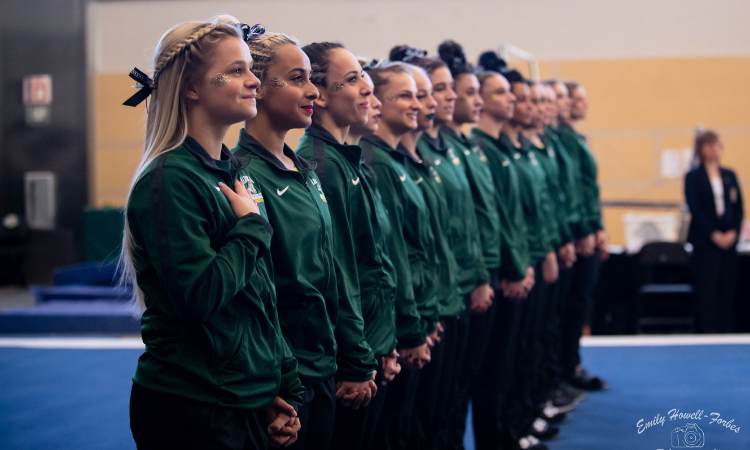With only weeks to go before the 2022 season kicks off, teams across the country are busy finalizing routines in preparation to battle for championships over the next few months. Up in Alaska, the Seawolves are busy with another task as well: fundraising money in hopes that their gymnastics team can be reinstated by the university.
Due to the COVID-19 pandemic causing budget shortfalls in university athletic departments across the country the past few years, athletic directors have recently been resorting to cutting programs to compensate for the deficits. While the pandemic wasn’t cited as an official reason, the University of Alaska school system announced a massive restructuring of its athletics programs in August 2019 to help offset a reduction in funding by the state, and gymnastics was one of the four programs eliminated in the reconfiguration.
“The university had a three-year agreement to reduce state spending on the university side, and we fell victim to the third year of reductions,” said Alaska head coach Marie-Sophie Boggasch. “We would be in the position of being eliminated regardless of the pandemic, but it has made it much harder to fundraise.”
Despite gymnastics being a non-revenue generating sport at every sponsored school, fundraising is typically not an activity teams and coaches have to participate in. At most universities, funding for the gymnastics team (and most other sports) comes from ticket sales, football revenue and donations. Some schools will take part in small fundraising efforts, particularly when big-ticket items like new equipment or renovations are needed, but in general, teams are not active participants in raising funds for their teams.
“We have a fundraising arm of the athletic department that goes out and raises most of the money for things we need,” said LSU gymnastics head coach Jay Clark. “We’re involved, but it’s not put on us that we have to meet a certain number or spearhead those efforts.”
Budgets for NCAA teams range drastically by school, with differences in what expenses are included as well. At some universities, coaches’ salaries and student-athlete scholarships are factored into a teams operating budget, but elsewhere those are covered by separate endowments or scholarship funds managed by the university. At LSU, where gymnastics scholarships are currently endowed and not factored into the teams’ budget, Clark estimates the budget falls between $2.5 to $3.0 million annually. At Alaska, where gymnastics scholarships are figured into the teams’ expenses, the team has a $370,000 budget for the year.
After Alaska’s program was cut but given the opportunity to fundraise for its reinstatement, Boggasch has been hard at work shrinking the Seawolves’ previous $444,000 yearly operating budget in an attempt to help the teams’ longevity. Boggasch says Alaska’s budget can be broken down into relatively equal quarters, with coaches’ salaries, student-athlete scholarships, travel and “commodities” each taking up around 25%. Recruiting, apparel and equipment are all examples of those “commodities,” or annual expenses gymnastics teams factor into their budgets, and are all the areas in which Boggasch has dedicated herself to finding ways to spend less.
“We’ve had to really cut back on the fun things, the things that are good for the athletes,” said Boggasch, who has also worked out multiple deals and donations to cut back on spending. ERIN’s has made a donation to the program to outfit the Seawolves with new competition leotards and warmups for the next five seasons should the team be reinstated, while a deal between the university and Alaska Airlines allows for reduced travel costs flying to competitions and bringing in opponents.
At schools with larger budgets, coaches have more autonomy and freedom in regards not only to setting their teams’ budget, but also what the funds are allocated toward. A budget priority for Clark is recruiting, an area where he speculates most SEC teams are above-average spenders. Clark estimates that LSU approaches six-figures annually in spending on recruiting.
“Recruiting for us is the largest single line item that we have on an annual basis outside of salaries,” said Clark. “That’s the lifeline of what we do.”
With such discrepancies in budgets across NCAA gymnastics, it’s easy to infer large discrepancies in performance related to budgets, too. Both Boggasch and Clark unfortunately agree that discrepancy exists in many ways, with the biggest contrasts in resources and recruiting. For example, this offseason LSU was able to hire a new assistant coach and volunteer assistant coach while Alaska, due to budget cuts, had to eliminate a paid coaching position.
“I think it’s true in every sport, unfortunately,” said Clark. “Is it the only factor? No. You can look at a program like Berkley [California] where Justin [Howell] and Liz [Crandall-Howell] have done an amazing job without some of the resources other schools in their conference or the SEC do.”
Despite the differences, setbacks and still having to fight for reinstatement, Boggash remains positive about the future of the Seawolves’ program.
“At this point, we are trying to exist, but we don’t let the student-athletes feel that,” said Boggasch. “We’re winning just by competing. We’re getting an opportunity we didn’t think we would.”
The University of Alaska gymnastics team is still fighting to prevent being cut and for permanent reinstatement. The Seawolves are still over $200,000 short of the $888,000 fundraising goal due June 30, 2022. Please click here for more information on how to support the University of Alaska’s gymnastics team.
READ THIS NEXT: International Student-Athletes Are Missing out Big on NIL
Article by Brandis Heffner
Like what you see? Consider donating to support our efforts throughout the year! [wpedon id=”13158″]





3 comments